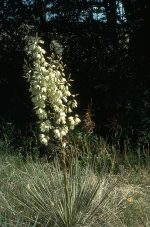 Native to dry rocky soils of central US and Canada, this evergreen herbaceous perennial has many common names including beargrass, Great Plains yucca, narrowleaf yucca, and Spanish bayonet. It is a member of the asparagus family, Asparagaceae, that also includes agave, scilla, and lily of the valley. Growing from a deep taproot, the plants form a large basal rosette of gray-green to blue-green leaves that are one-half inch wide, 12-18” long, and have sharp pointed tips and pale gray-green margins and threads. In summer waxy bell-shaped flowers appear on slender racemes up to 3′ long. The pendant flowers are 2″ long, fragrant, greenish-white flushed with red, and are atractive to butterflies. Because plants do not bloom every year they are best planted in clusters, although the foliage is considered ornamental. Soapwort is a striking architectural plant in borders and provides food, cover, and nesting sites for wildlife. It is very drought tolerant and a good choice for a desert garden or xeriscape. Native Americans used the peeled roots to make soap for washing clothes and blankets, giving the plant its common name. The genus name, Yucca, is from the Carib name for manihot or cassava, plants that are not related. The The specific epithet, glauca, is the Latin word for having bloom, the white powdery substance on the leaves. Type: Evergreen herbaceous perennial
Native to dry rocky soils of central US and Canada, this evergreen herbaceous perennial has many common names including beargrass, Great Plains yucca, narrowleaf yucca, and Spanish bayonet. It is a member of the asparagus family, Asparagaceae, that also includes agave, scilla, and lily of the valley. Growing from a deep taproot, the plants form a large basal rosette of gray-green to blue-green leaves that are one-half inch wide, 12-18” long, and have sharp pointed tips and pale gray-green margins and threads. In summer waxy bell-shaped flowers appear on slender racemes up to 3′ long. The pendant flowers are 2″ long, fragrant, greenish-white flushed with red, and are atractive to butterflies. Because plants do not bloom every year they are best planted in clusters, although the foliage is considered ornamental. Soapwort is a striking architectural plant in borders and provides food, cover, and nesting sites for wildlife. It is very drought tolerant and a good choice for a desert garden or xeriscape. Native Americans used the peeled roots to make soap for washing clothes and blankets, giving the plant its common name. The genus name, Yucca, is from the Carib name for manihot or cassava, plants that are not related. The The specific epithet, glauca, is the Latin word for having bloom, the white powdery substance on the leaves. Type: Evergreen herbaceous perennial
Bloom: Racemes of waxy, bell-shaped, greenish white flowers in summer
Size: 3-6’ H x 2-3’ W
Light: Full sun; tolerates some shade
Soil: Average, dry, medium moist, well-drained
Hardiness: Zones 3-10
Care: Low maintenance
Pests and Diseases: Agave plant bugs, aphids
Propagation: Seed, division of offsets
Companion Plants: Pussytoes (Antennaria plantagninifolia), eastern prickly pear (Opuntia humifusa), prairie smoke, (Geum triflorum)
Photo Credit: Clarence A. Rechenthin Wikipedia